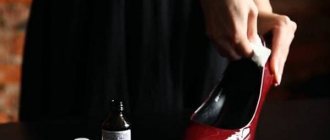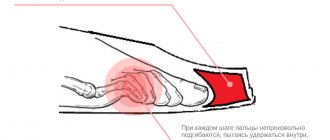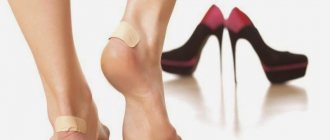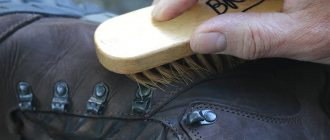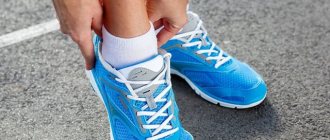Imagine: you bought new blue suede boots. We immediately put them on and ran to work in the rain. Then - in them - at work for nine hours. After a hard day, we splashed around in them through the puddles to the store. And then they came to visit and took it off... and their feet were blue from toes to heels. It seems like nothing bad was done to the shoes, so why are the feet painted? After reading this useful article, you will understand that in this little story, every step is a mistake. So, what should you do if your shoes are painted on the inside? How to prevent the process? Detailed instructions with useful tips below.
Why are shoes painted?
There may be several reasons:
- Getting wet. Tights, socks or the foot itself can easily become stained if the shoes allow moisture to pass through. In slushy weather, for example.
- Sweaty feet. Sometimes the paint eats away easily if your feet sweat a lot.
- Shoe quality. The reason may be in the product itself: if it is of poor quality, it may well stain the skin or clothes. This can be recognized quite easily. Low quality shoes will stain the entire foot, not just part of it. If only the heel is stained, for example, then this is not at all an indicator of cheap material. Sometimes such consequences are normal for new shoes or boots.
- Incorrect care. Even the most expensive and high-quality shoes can stain if they are not properly cared for. Or vice versa - the owner of leather boots uses the cream so often that the substance negatively affects their condition, sometimes even penetrating inside.
- Wearing period. Shoes can stain if worn too long. Over time, the top layer inside may wear out. And the one underneath is easy to paint. It is not advisable to wear the same shoes all the time. Wearing boots at work all day is a sure way to stain your feet. Especially if they haven't dried properly.
- Dark insole. Manufacturers sometimes use dark material for the insole. And it is just capable of staining the skin, especially if it is made from raw materials that are not of the best quality. In this case, the problem is solved by simply replacing the insole with a light one.
Possible reasons
The most important thing is considered to be that the purchased shoes are of poor quality. And this occurs not only with cheap purchases, but also among goods whose manufacturer there is no doubt about. This happens when shoes are painted only on the heels, where natural leather is placed on the heel with the back side facing out. And this is considered a normal fact; if you don’t do this, your foot will slip.
Shoes are also painted for the following reasons:
- with excessive moisture;
- care products for a particular couple were chosen that were not suitable in composition;
- poor quality of the product when painting the entire foot;
- the insoles had worn out from long wear, exposing a layer of paint;
- lack of protection from the sun and sudden changes in temperature during storage.
When choosing shoes, you need to pay attention to the color of the insole. Light colors will not paint your legs as well as those made from dark material.
Traditional methods
But whatever the reason, a problem has arisen - it needs to be solved. Before turning to expensive professional products, try what you have at hand.
Attention! All attempts to get your shoes in order will be in vain if you carry out the treatment without first drying them.
Hair fixation spray
Shake the can. Apply an even layer to the inside of the boots. A little more - in those places where the material is particularly colored. Let it dry and apply the polish a few more times. It will fix the paint, and your legs and clothes will stop staining. To maintain the effect, the procedure must be repeated every 3-4 weeks.
Attention! The only caveat is that the varnish is washed off when it gets wet. Therefore, the method is ineffective during periods of slush and rain.
Alcohol
Alcohol has the opposite effect of varnish - it does not fix, but washes away excess paint. It is most convenient to first pour it into a spray bottle. Spray alcohol onto a cotton pad and let it soak thoroughly. Wipe the inside of the shoes. Blot especially generously those areas that stain more than others. Don't be afraid to overdo it with alcohol - it evaporates quickly. Dry your shoes in natural conditions, without a battery or hair dryer.
Burr oil
Soak a cotton pad or cloth in the oil and wipe the inside of the boots. You need to literally saturate the painted areas with oil, but do not overdo it - it should not run off. Leave the boots to dry in a well-ventilated area, ideally on the balcony. Wait until it dries completely, and then there will be no marks.
Attention! This advice is only relevant for shoes made of artificial material. There is a possibility that the oil will seep through natural fabrics and skin.
Table vinegar
To prevent shoes from staining, you can use regular table vinegar. Here's why: acid is a good paint fixer. At the same time, it is also able to eliminate unpleasant odors. Mix vinegar with cold water in a 1:2 ratio. Soak a cloth in the resulting solution and wipe the inside of the shoe. Try not to leave untreated areas. Dry in fresh air to remove the acidic smell. If the smell is still noticeable after complete drying, spray the inside of the shoe with foot deodorant.
Attention! Apple, wine, etc. are not suitable for this method. vinegar. Use regular, transparent.
Talc
Talc can also cope with the problem. If you don't have it, you can use starch. The powder should be distributed over the entire inner surface, rubbed thoroughly in a circular motion, and the remaining residue should be carefully collected with a dry cloth or vacuum cleaner at low power.
Paint thinner
Dampen a rag or sponge with solvent and rub into problem areas for 1-2 minutes. Leave it to ventilate in the fresh air for 24 hours.
Advice! Use a light-colored cloth for processing to understand whether the material is dyed. Repeat the procedure (usually 3-4 times is enough) with a new rag until it remains clean after treatment.
Attention! Before use, try to test the solvent on a small area to ensure it is safe for use on shoes. If there is a risk of damaging the finish, try using nail polish remover. It contains much less concentration of aggressive substances.
People who are fond of drawing can probably find artistic remover - also an effective substance in the fight against highly staining materials. There is no point in using a product that is too aggressive - it can ruin the surface. But a wash for brushes is perfect. Apply in the same way as a solvent.
Relieving swelling during pregnancy
In the body of a woman carrying a fetus, the concentration of the hormone progesterone increases. It is one of the causes of edema during pregnancy. In no case should it be reduced, because it is this that ensures the attachment of the embryo.
There is no need to fight physiological swelling. The main thing is to prevent it from getting worse. To alleviate the symptoms, you can carry out the mentioned water procedures and adhere to a healthy lifestyle (moderate activity, water consumption within the daily norm, adjusted for restrictions imposed by pregnancy, rest on your side).
The pathological nature of edema can only be determined by a doctor based on test results (in particular, protein in the urine). Having discovered the cause, he will prescribe treatment. It is prohibited to take any medications on your own.
Professional products
The issue of “dyeable” shoes has become so pressing that products to solve this problem have already appeared on the market (AntiColor, StopColor). The main rules for choosing such a product:
- Give preference to well-known brands: Tarrago, Saphir, Salamander. Yes, they are an order of magnitude more expensive than those that have little-known names. But the result will be as predictable as possible.
- Try to find out if the product has a smell. It is usually very difficult to remove it later.
Advice! Don't ignore the instructions. These remedies are more active than traditional ones. You need to be more careful with them.
In what cases can shoes be returned to the store?
- If it is painted not partially, but entirely. And abundantly.
- Provided there is a receipt and the packaging is intact.
- If you discover a defect before wearing. If you have already worn your shoes and they already show signs of use and mechanical damage, returning the purchase to the store becomes impossible.
- If the issue of operation is controversial, you can submit a statement to the consumer rights service. Further, the decision will be made according to the examination performed. However, remember that the consumer pays for the expert services.
Attention! According to the state standard, painting shoes with unstable paints is unacceptable.
Returning a purchase
If the shoes are painted on the inside , returning them is not a problem. You can safely take new shoes to the store, arguing that shoes make your feet look good. If the shoes are completely new and the receipt is still available, the person is required to return the full purchase price.
If the seller does not want to accept low-quality goods, then you can safely contact the relevant authorities. According to GOST standards, unstable paint pigments are not allowed, therefore, the court’s verdict is already obvious.
Of course, the vast majority of consumers are not ready to go to court over one purchased pair of shoes. In addition, it is not so easy to prove that you are right: you first need to conduct an examination, and this procedure is expensive. The money is returned after the trial, but is it worth spending so much time for one pair of dyed socks? But the seller must see the buyer’s determination, under this pretext he will agree to return the money.
How to remove paint from feet?
A logical question: what to do with your feet if your shoes have stained them too? After all, the dye penetrates into the skin much more strongly than into socks or tights. There are several ways to wash your feet:
- Rub your heels with a pumice stone and your toes with a nail file or scrub.
- Wash with soap and warm water (you can soak it a little in a bath of soapy water).
- Try treating the leather with alcohol or nail polish remover. This method is only possible if there are no scratches or abrasions on the skin of the legs.
Advice! After any of the methods, lubricate the skin of your feet with a rich cream.
Treatment of leg swelling due to heart or kidney failure
Patients with heart or kidney failure should be under the supervision of a physician. In acute attacks, resuscitation is required. If the disease takes a chronic form, swelling is removed as it appears with the help of diuretics and nutritional correction. Medicines should:
- stabilize blood pressure;
- remove excess sodium from the body;
- prevent protein loss;
- normalize blood flow speed.
When using diuretics (diuretics), it is important not to exceed the permissible dosage. Otherwise, there is a risk of getting the opposite effect in the form of drug-induced edema during withdrawal. They are caused by the kidneys’ reaction to a sudden change in the mode of fluid excretion.
Tips for care and use
- It is better, of course, to buy a quality product from a manufacturer proven by experience and time. Although such shoes are more expensive, they will last you longer, and most likely they will not need to be painted.
- Try to purchase shoes with a light-colored heel and insole. Then the likelihood that after half an hour of wear your feet will acquire an unexpected color will be minimized.
- If it is not possible to follow the previous advice, then there is a second one - to prevent staining. To make sure your new boots don't stain your stockings or feet, walk around in your shoes at home for an hour. Wear socks that you don’t mind getting dirty (preferably light ones to see the scale of the problem). First, dip your socks in alcohol mixed with water, or better yet, spray the solution on it so that they become slightly damp.
- Repeat the manipulation until the coloring disappears or at least becomes weaker. The paint will definitely come off in a couple of times.
- Wear shoes appropriate for the weather. Getting water on any shoes other than rubber boots is fraught with consequences. Try to avoid this if possible. If your shoes do get wet, be sure to let them dry completely. Never wear shoes that are even slightly damp - they will definitely stain your feet.
- It’s trite, but proper care is half the battle. Even with low quality shoes. Also, you should not purchase paints and shoe polishes of dubious quality.
- If your feet sweat a lot, consult a specialist at the pharmacy and buy a special drug. It will not only prevent your feet from staining, but will also protect you from discomfort and excess odor.
- Any treatment should be carried out only on dry and clean shoes. Otherwise, all efforts will be in vain.
4.Bemer therapy
In our medical practice, Bemer therapy has proven to be the most successful way to combat any type of pain. BEMER therapy is electromagnetic physiotherapy from Switzerland, the main goal of which is to improve blood circulation.
The Bemer device consists of three elements: an induction mattress aimed at general health improvement, a reinforced applicator - a device that allows you to influence a specific place, and a laser magnet, which has the strongest effect on the pain point
read more about Bemer therapy by following the link. If you want to get a consultation or make an appointment, you can do this using the feedback form or by phone: +7-495-212-08-85
Sign up for a consultation
